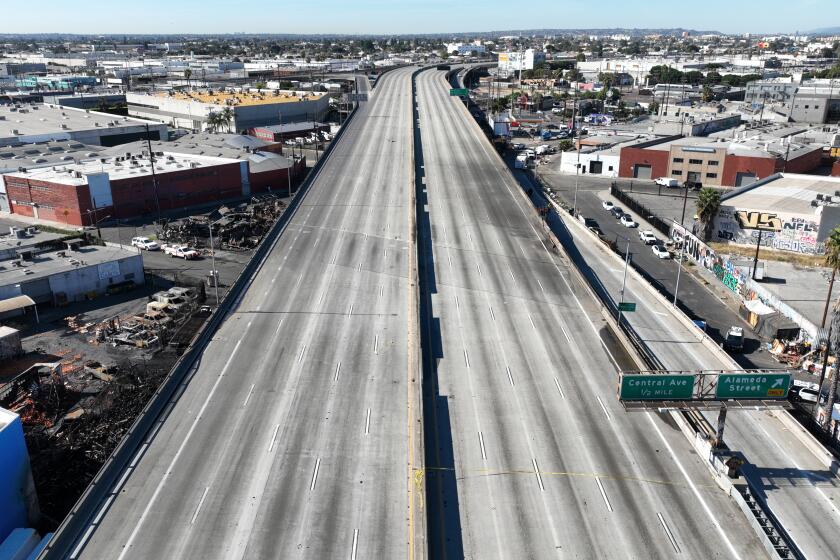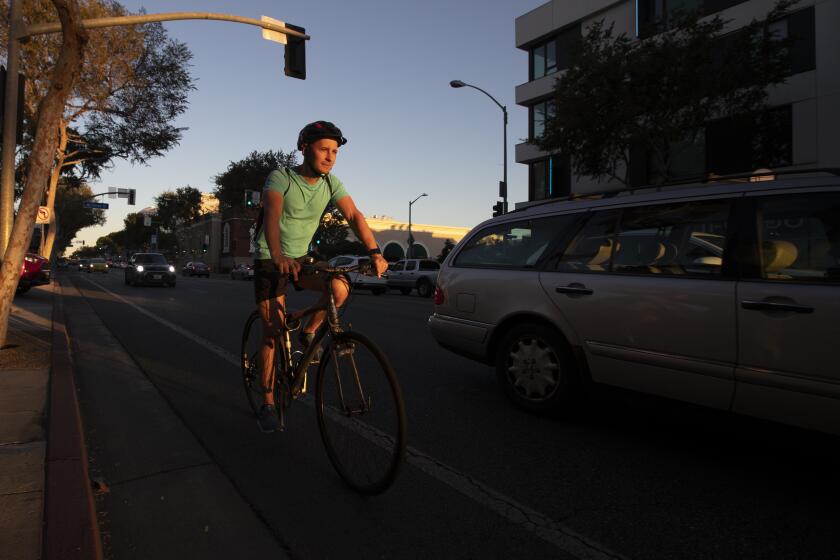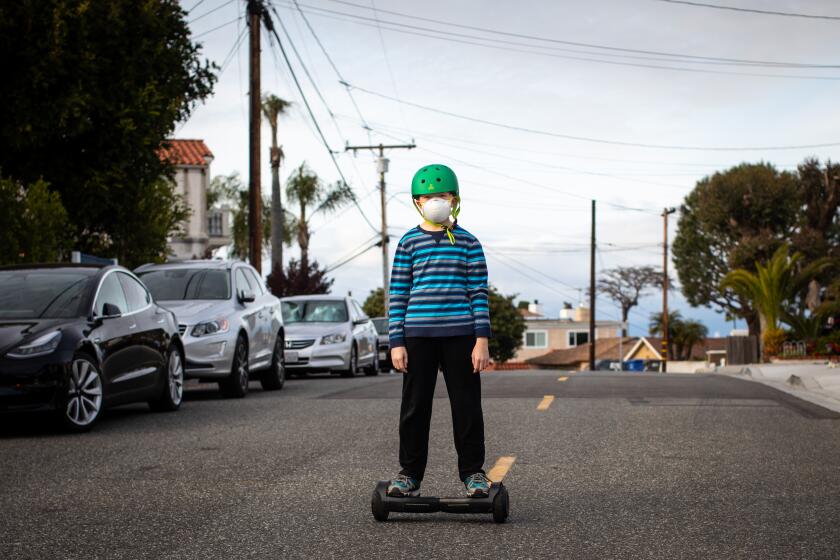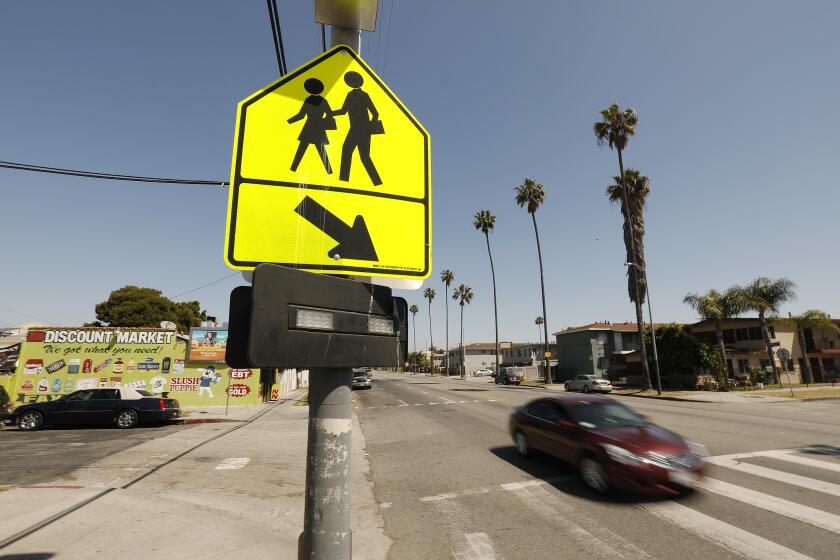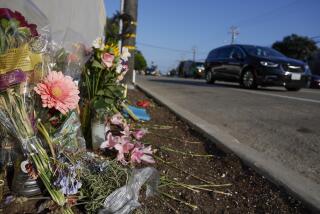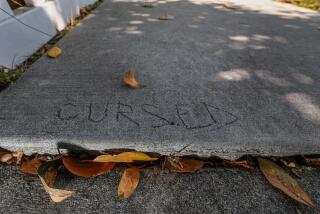Opinion: L.A. doesn’t need ‘Watch your speed’ signs. It needs safer roads

On Oct. 17, four Pepperdine students were standing on the side of Pacific Coast Highway in Malibu when a driver going 104 miles per hour lost control of his car and crashed into parked vehicles, which crushed the women. They died at the scene.
This kind of traffic death shouldn’t be called an accident (as the City Council recently agreed). In Los Angeles County and beyond, we seem to have accepted constant carnage in our streets in exchange for maximizing driver speed and convenience.
The freeway shutdown shows the car is still king in Los Angeles. This is a moment to expand transit services to help commuters now and encourage people to keep using buses and trains after the route reopens.
The official responses to proven traffic hazards are woefully inadequate — mere gestures, if even that.
In 2021, after Monique Muñoz was killed on Olympic Boulevard at Overland Avenue by a driver going more than 100 miles per hour, the city placed a “Watch your speed” sign, politely asking drivers to slow down. Unfortunately, in the over two years that have passed, the city has yet to meaningfully redesign Olympic Boulevard to prevent a crash like this from happening again.
There’s an unavoidable inconvenience to drivers when adding sufficient bike and bus lanes, but the benefits for all of us are far greater.
People don’t drive based on signage. They drive based on the design of the street. In the case of Olympic Boulevard in West Los Angeles, the design screams “wide open highway,” a lot like the Pacific Coast Highway. Hazardous as this is to all people (including drivers), it is most dangerous to pedestrians and cyclists.
From January through mid-October, 134 pedestrians had been killed by vehicles in the city of Los Angeles; 427 more had been injured. This represents a year-to-date 13% rise in pedestrian deaths and an 18% increase in severe injuries.
Vehicle sizes have ballooned in recent decades, and now children would be unsafe on bikes. History shows us a better approach.
Los Angeles is a uniquely deadly city in which to be a pedestrian, with a fatality rate that is four times the national average. Unsurprisingly, it’s also a city that has been designed with one thing in mind: a concept called level of service, which grades streets on how well they serve those in automobiles. An “A” grade means free-flowing traffic; an “F” basically means total gridlock.
To many Angelenos, that makes sense — to design our streets for car traffic, which is the way many get around the city. Unfortunately, there’s a trade-off. We can either have streets optimized for free-flowing traffic (that is rarely, actually, free-flowing), or we can design streets for people to move around safely outside of cars, such as walking and biking. Doing both is impossible.
It’s going to take a sea change in our thinking to make roads safer
City leaders consistently opt for the easy — and deadly — option when faced with this choice. In one recent example, a resident asked the city’s Department of Transportation to block drivers from using Cochran Avenue at Venice Boulevard as a cut-through street, as they were speeding through an otherwise quiet residential neighborhood. The department responded by suggesting a “speed awareness campaign” in which neighbors put up yard signs urging drivers to slow down.
The arterial roadways of Los Angeles such as Venice Boulevard all need to be modified so that people are prioritized over cars. This would include narrowing travel lanes (a recent John Hopkins study says this would have substantial safety benefits), building bike lanes (which benefit all road users), adding more crosswalks and trees, and banning right turns at red lights. These and other measures would make drivers feel like they’re in a city and not on a highway.
We have more than 7,500 miles of streets in the city of Los Angeles. They won’t all be rebuilt anytime soon. But with each repaving or road construction project, and each crash, we should be reviewing and revising streets to make them safer for pedestrians, cyclists and drivers.
The solution to safety around schools isn’t crossing guards. It’s road redesign and protected intersections.
The solution to gridlock isn’t to make more space for cars. It’s to design the streets to be safe enough for alternatives such as biking, walking and mass transit (which can move far more people per hour), especially for the 50% of trips daily in Los Angeles that are less than three miles.
The solution to cars speeding on residential streets isn’t a yard sign campaign asking drivers to slow down. It’s speed humps, curb extensions, traffic diverters and other design changes that force vehicles to slow down.
The solution to protecting people dining outdoors in former parking spaces isn’t crash barriers. It’s a street design that forces drivers to go slowly.
The problem is carnage in the streets, and we know the solutions.
Michael Schneider is the founder of Streets for All.
